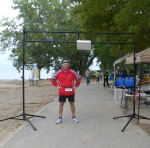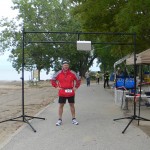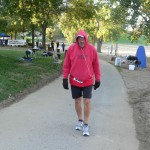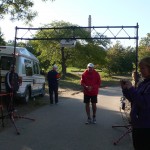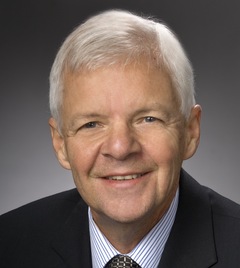At the North Coast 24-Hour Endurance Run in September of last year, Newton Baker placed first in our mutual age group. I logged the second greatest amount of mileage in that age group, but wasn’t a registered USATF runner, so didn’t qualify to receive a medal for my achievement.
Newton proceeded to rib me: “You should’a joined USATF. If you’da been a member, then you’da not only had a good race, you’da had a medal!” In that moment I resolved to return again in 2011, do my best, and secure a medal for myself.
Which I did. But how well did I do? Depends on how you tell the story. Spin is everything.
Last weekend my hope and realistic expectation was to finish with mileage in the mid-seventies. My actual finishing distance of 61.48 miles was exactly half a mile more than my personal 24-hour worst, set two years ago, and 3.93 miles less than last year. (For perspective, compare that to my personal best of 83.716 miles, set in 2001.) That made my overall finishing position (counting both genders) 125th out of 186 who logged distance, so 61 runners finished behind me. Of those not one was my age or older. In other words: many younger runners ran farther than I did; a few older runners ran farther than I did; but none of the runners I outperformed are older than me.
Got that? Does it mean much? Not a thing.
As I hoped, I earned my coveted medal for being second in the 65–69 age group in a national championship, the first medal other than a generic finisher’s medal I’ve ever gotten in a race. Woo, woo! Taken at face value it sounds impressive, right? Of course, Newton Baker won it again. He could beat me hopping on one leg. (Come to think of it, he’s got a nasty pin in one ankle that makes it difficult for him to run.) There was only one other runner in our age group but he didn’t register with USATF, or he would have walked off with the third place medal. But I did beat him, too.
At my age about all a person has to do to medal is show up. Knowing that, I trained a whole year to be able to do just that. I should have made a sign that said, “Don’t meddle with the man with the mettle to medal.”
The experience was rewarding as always.
These affairs invariably follow a similar progression.
First there’s the meet-greet phase, reunions with everyone you’ve known from previous races or from the Internet, while making new friends. Good vibes are always in abundant supply before a race.
In the close-knit world of ultrarunning I get to hug a lot of vibrantly healthy women. Hugged Debbie. Hugged Julie. Hugged Debra. Hugged Lisa. Hugged Shannon. Hugged some women I have no idea who they were, but who apparently know me because they initiated the hugging. I don’t mind. And my wife is a real good sport.
Dinner the night before was a doubly-special occasion, as it happened to be Suzy and my thirty-third wedding anniversary. Spending it with me at a race (not the first time, probably not the last) is further proof that she’s a good sport. Suzy enjoyed a Glenlivet with dinner. Single malt scotch whiskey may be my favorite taste in the whole world, and I haven’t had any in at least a year, but I remained alcohol-deprived because of the race the next morning. The evening before a race is no occasion for crapulous behavior. The food was good, the noise level of conversation, centered entirely on running, was animated and loud for a group of mostly sober people.
We arrived at the numinous running shrine at Edgewater Park by 7:25 a.m. on Saturday, September 17, to find hordes of runners and crews bustling about, already setting up, the tent village largely formed. I still managed to carve out a good spot for myself at my preferred location, exactly the same as the previous two years.
In recent years I’ve learned to execute these affairs mostly without any crew support at all. Suzy helped me set up my table, then scurried off to help with with registration. She left early to return to (race director Dan and) Debbie Horvath’s house in order to help with preparing breakfast for the next morning. I never saw her during the middle twenty-two hours of the race.
Some of the newer folks fret obsessively about gear and clothing and gels and performance products, but I’m betting all that fuss does little to help them. All a person really needs to do is to train well, show up on time, put down maybe a chair and a gym bag — to hold the gym bag off the ground, because after all you come there to run, not sit in a chair — and keep exercising gumption until the race is over. The rest usually takes care of itself, and if you need help, it’s not hard to find some.
My system entails the use of a folding camp table; a white hard plastic box about the size of a shoebox filled mostly with chemical substances — Succeed, ibuprofen, Pepcid A/C, ginger, sunscreen, lip balm, caffeine, and potassium; a gym bag with extra clothing; a single water bottle; and a camp chair, just in case.
If I’d had a crew urging me to eat or drink this or that when I didn’t want to eat or drink this or that, or to run faster when I couldn’t, I probably would have decked them. I’m always doing the best I can, even when that’s not very good. In fact, especially then. In an ultra, if you’re comfortable, you probably aren’t running hard enough.
The first four hours of the race I ran most of the time, except for the short segments on the 0.90075-mile certified loop where the path rises slightly. Unless you are a runner who expects to be able to run (meaning not walk) the entire 24 hours, running up even gentle inclines is a needless waste of energy.
The day was beautiful and cool, and the long-familiar racetime ambiance served happily to divert my attention away from the many cares that have preoccupied my thoughts day and night of late, allowing me to concentrate only on running, enjoying the experience at the beginning, knowing that discomfort and suffering were advancing like a cavalry charge and would soon envelop me. From hours eight until twelve I still ran as much as I could, but increasingly less.
I was the last person to finish a lap before the twelve-hour halfway split, at which time I had gone 41.43 miles. This compares with 45.04 last year, which I regarded as exceptional at the time; I expected to get less this year.
Even though by this time I was already reduced to walking most of the time, my plan of action for getting well into the 70-mile range was to stay out on the road longer. Both the previous two years I had terrible troubles fighting sleep. Furthermore, I learned to my dismay that for me caffeine tablets either serve as a miracle drug, or they upset my stomach so badly I get dry heaves. Not fun.
My new strategy for staying awake depended on heavy doses of Red Bull, one can per hour during the late night hours, a technique I learned from Jan Ryerse in 2003, when he won the Across the Years 72-hour race, and I was second male finisher. Jan didn’t sleep the entire race, nor for several hours before and after it.
There was only one minor caveat to that plan. I’ve drunk only one can of Red Bull in my life and I hated it. But I know it’s effective, so I’d just chugalug the contents like medicine and get on with business. Ultramarathons are not occasions for gourmet dining. How bad could it be? Red Bull may be unadulterated poison, but some people actually drink the stuff because they like it.
When I ran my proposal by sagacious Dr. Lisa Bliss before the race, she wondered if I’d ever actually tried it. Well, no. In addition to the caffeine, Red Bull has large amounts of sugar to deal with. It could lead to a crash. The caution may have affected me psychologically.
Clever plans are often subject to the vicissitudes of reality, and there was indeed a flaw in my method. I ate and drank copiously while topping off my electrolytes with Succeed regularly the first twelve hours, just as a wise ultrarunner ought to do, and was feeling fine — until I ate that second slice of pizza not long before the halfway point. That’s when mild nausea set in, along with the indomitable realization that it was bedtime. My habit of late is to turn in somewhere between 9:00 and 10:00 p.m., since it’s not unusual for me to get up around 4:00 a.m., sometimes even earlier. My normal day, one in which I’d worked very hard physically, was coming to a close, but I had a much tougher one still ahead of me.
I tried to remind myself it was still at least an hour too early to start on the Red Bull, but the arguments I presented were moot because I just wanted to crash like an airplane running on fumes. The grass by the side of the path was looking mighty tempting. In the end I never touched the stuff, as I was unable to convince myself that pouring bad-tasting sugar-and-caffeine-laced jet fuel into my already protesting stomach would be a good idea.
Also, the temperature was dropping, and there was a bit of wind whipping up off the lake. The low temperature at night was about 50 degrees, not bitter, but uncomfortable for a greatly slowed runner wearing soggy, stinking clothing. My gloves (wet with night moisture), a jacket, and a sweatshirt were barely adequate. Some runners ran with far less, and Jonathan Savage, on his way to over 146 miles, ran without a shirt the entire night.
I took advantage of the fact that Suzy left our car at the park for me and crawled into the back seat, where I fell sound asleep in a few seconds, intending to sleep just long enough to knock out the grogginess — maybe ten or fifteen minutes. When I woke up I misread my watch and was flummoxed into thinking — mistakenly — that I had slept well over five hours, thereby obliterating any possibility of having a good race. What I really saw was the time elapsed since the last time I pressed the lap split button on my timer, which I didn’t automatically do each lap, and hadn’t done for hours.
Furthermore, when I got back on the track, my head still in a fog, I didn’t realize that the race clock, which evidently doesn’t count any higher than 12:00:00, had been reset at the midpoint (9:00 p.m.) to count backwards to zero — and I never heard any announcement about that. It took me at least three laps to realize that, then to calculate the time of day, from which I estimated I was only down for an hour or so. Don’t ask why it never occurred to me to simply switch my watch to the time mode to get the time of day. An hour was still longer than I intended, but much better than over five. It also meant that I had a long time to go before the end of the race.
Alas, all good intentions to the contrary, I continued to fight drowsiness until dawn. As usual, when the first signs of light appeared, by which time I’m usually halfway through a pot of coffee and busy with projects, my energy returned, and I managed to keep on shuffling along among the other survivors until the end.
At 8:00 a.m. Suzy appeared on the path with a camera to record my sorry condition for posterity, then disappeared into the ramada to help with breakfast.
At the end, there are always runners who quit after the last whole lap they can get in, but as always, I grabbed a stick with my number on it and pressed on to log as many additional 100-yard segments as possible before the siren sounded and everyone still on the track suddenly stopped in their tracks and dropped their sticks, which must be fun to see standing in the middle.
And so another successful North Coast 24-Hour USATF National Championship Endurance Run came to an end. Runners out on the course staggered across open fields back to the start area to get some delicious breakfast (for those who could stomach it), pack up, and listen as race director Dan Horvath read off the names (but in a break with tradition, not the mileages, which were still not official) of the top ten open performers in each gender (there’s money for the top three), then announced the age group winners. Mercifully, Dan finished up the awards in record time. Afterward, it didn’t take long for most runners and crew to vamoose, while clean-up crews stayed behind.
Since 1999 I’ve spent 34 24-hour days of my life circling tracks, not counting any of the 2010 Across the Years 72-hour race, which illness exacerbated by foul weather forced me to bail out of after seven and a half hours. Fixed-time running is my favorite format because it suits my personal skill set, training methods, and personality well. Whether I will be running any more such races remains to be seen. All good things come to an end, and no one does just one thing his whole life. I have no current plans for another race, but I’ve learned not to burn any bridges behind me.
North Coast is an excellent race, entirely deserving of recognition as the US national championship. It’s customary after successful events to hear cascades of bathetic plaudits from satisfied customers, along with the inevitable slew of affirmations that declare: “I’m definitely coming back to this one next year!” as runners always assume that there will be a next year. Whether there will be a North Coast race in 2012, I have heard from good authority, is a question that has by no means been determined. But if there is, it will be a good race.
